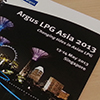 It’s no secret that the recent boom in Shale Gas and in gas production in general is set to increase the supply of Liquefied Petroleum Gas (LPG) to Asia. However at the recent Argus LPG Asia 2013 event in Singapore, those of us lucky enough to be in attendance had the opportunity to discuss the finer detail of what this will actually entail.
It’s no secret that the recent boom in Shale Gas and in gas production in general is set to increase the supply of Liquefied Petroleum Gas (LPG) to Asia. However at the recent Argus LPG Asia 2013 event in Singapore, those of us lucky enough to be in attendance had the opportunity to discuss the finer detail of what this will actually entail.
The event gathered together more than 60 industry participants for two-days of information-packed sessions, detailing the current state of the global LPG supply chain. The presentations coalesced around this overarching theme of increasing LPG to Asia and the likelihood of prices being driven down.
The Global Effects of ‘Shale Shock’
Taimur Baig, Chief Economist with ASEAN, gave an informative presentation
detailing the global effects of “Shale Shock”. With the advent of horizontal drilling fracking technologies have put into play traditionally uneconomical oil and gas areas, such as the US Marcellus shale formations. These newly developed resources means US dependence on imported oil is decreasing. American WTI crude oil prices are dropping relative to European Brent and all refined products in the US, such as LPG, are stockpiling and looking for a better priced home. Indeed, Argus data indicates that Asian LPG prices are currently tracking their chief supply sources in Middle East – from suppliers such as Saudi Aramco. On the other hand, North America LPG prices, measured at Mt. Belvieu, is cheaper by more than $150 USD/ton compared to Asian and Middle East prices. This is due to a perfect storm of excess shale oil and gas, extensive refining capacity and the lack of enough LPG export infrastructure.
Figure 1: Average LPG Contract Prices in Asia, Middle East, North America (Argus Data with Analytics provided by ZEMA 4.0)
Current and Projected LPG Infrastructure Projects
Amy Strahan, Argus editor for NGL Americas described the current and projected LPG infrastructure situation. As mentioned before, Liquified Petrolum Gas (LPG) exports from North America to Asia is currently constrained by the lack of suitable LPG terminal infrastructure, but this situation is expected to improve in the near future as major projects get underway.
The European trading firm Vitol and Japanese trading house Itochu recently joined forces in February to develop a LPG export facility in Beaumont, Texas. There they have been taking advantage of the natural salt caverns suitable for large scale LPG storage. The development is slated for completion in mid-2014.
Sunoco Logistics Parnters LP and Lone Star NGL and the Intercontinental Terminals Co in Texas are slated to complete their terminals in 2015. Just two of these terminals will add the capability to transport in excess of one million metric tons of LPG per month. The speculative proposal to build Enbridge Northern Gateway pipelines connecting the US Gulf’s supply with Canada’s oil sands to Pacific terminals in Kitimat again underscores the drive to move cheap North American energy to Asia.
Figure 2: North America NGL Inventories vs 5-Year Average (Courtesy of Amy Strahan’s presentation)
The Panama Canal Expansion Project
Silvia de Marucci, Senior Market Analyst for the Liquid Bulk Segment, Panama Canal, provided an update on the Panama Canal Expansion Project and its effect on global LPG trade. This expansion is estimated to roughly double the current capacity of the canal by 2015. In a nutshell, the project costs $5.3 billion USD to finance, and will dig two new sets of locks – one on the Atlantic side, one of the Pacific side, to accommodate larger ships. In the context of LPG, the new locks will accommodate Very Large Gas Carriers (VLGCs), with gross tonnage exceeding 47,000 tons. When operational, VLGC transit times from the US Gulf Coast to Japan will decrease from 80 days (around Africa’s Cape of Good Hope) to 50 days through the canal. The cost savings based on today’s transport prices would be about 30%.
Figure 3: Dimensions of Locks and Ships (courtesy of Silvia’s presentation)
Cheap LPG will come directly from the US from its newly built terminals and through a newly upgraded Panama Canal, or through the not yet built Enbridge pipelines. Alternatively it may come indirectly, with the excess LPG following into Europe, and displacing Middle Eastern supplies to Asia. In any major paradigm shift there are winners and losers. Winners include energy importing countries like India, Japan, South Korea, Taiwan and Thailand, who can look forward to flat long term energy prices, low inflation and good balance of trade outlook. Potential losers include raw energy-exporting countries like Australia, Indonesia, and Malaysia. The silver lining for the latter two emerging economies of course, is that they’re also major LPG consumers whose populations would benefit significantly from reduced fuel costs.
How do flat, long-term LPG prices in Asia affect your firm?
Let me know your thoughts by commenting below, or emailing me at yi-jeng.huang@ze.com.
Next article, I’ll discuss LPG outlook for various emerging economies in Asia.







